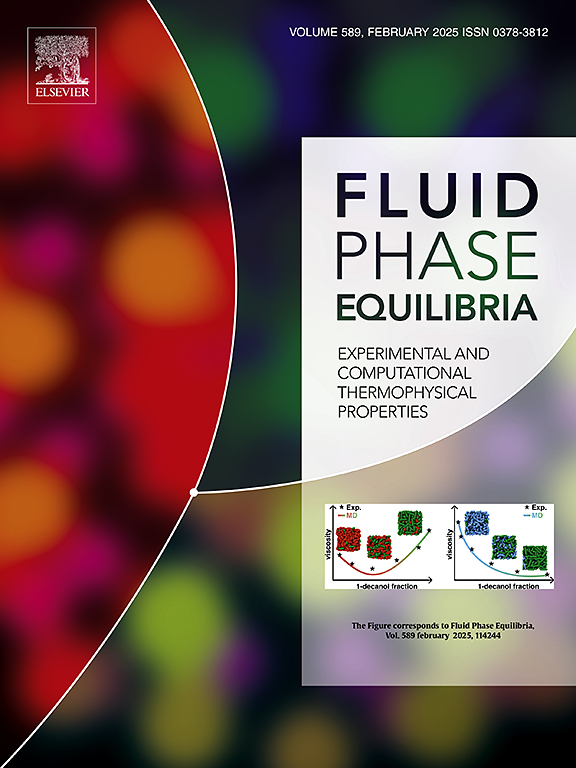纳米结构对离子液体输运性质的影响
IF 2.7
3区 工程技术
Q3 CHEMISTRY, PHYSICAL
引用次数: 0
摘要
通过系统、高分辨率地研究7种离子液体(ILs)同系物系列[CnC1im]BF4、[CnC1im]PF6、[CnC1im][OTf]、[CnC1im][FAP]、[CnC1im][NTf2]、[CnC1pyr][NTf2]、[Cnpy][NTf2]粘度和电导率的温度依赖性,探讨了纳米结构对离子液体(ILs)输输性能的影响。烷基链长度的增加增加了粘度,降低了摩尔电导率,这是由于液体的总体迁移率降低和范德华相互作用的增强。将输运性质的温度依赖性拟合到VFT方程(VFT)中,并推导出能量势垒和指数前系数。得到的结果突出了输运性质曲线的趋势转移(n = 6-7),这反映了纳米结构的增强,并描述了从具有强离子特征的液体到以疏水域为主的纳米结构液体的转变。推导出的能垒约对应于离子液体的0.2-0.35个内聚相互作用,其中球形阴离子BF4−和PF6−比更大、更拉伸的阴离子(如NTf2)表现出更高的分数。发现该馏分不受烷基链长度的影响。非极性区域的增加也反映在与理想瓦尔登关系的更明显的偏离上。这突出表明,由于电荷分布的不均匀性,与粘度相比,电导率增加了复杂性,揭示了离子表面体积比和阴离子-阳离子尺寸比的影响。本文章由计算机程序翻译,如有差异,请以英文原文为准。

Impact of nanostructuration on the transport properties of ionic liquids
The impact of nanostructuration on the transport properties of ionic liquids (ILs) was explored by a systematic and high-resolution study of the temperature dependence of the viscosity and electrical conductivity of seven ILs homolog series: [CnC1im]BF4, [CnC1im]PF6, [CnC1im][OTf], [CnC1im][FAP], [CnC1im][NTf2], [CnC1pyr][NTf2], [Cnpy][NTf2]. The increase of the alkyl chain length was found to increase the viscosity and decrease the molar conductivity due to a reduction of the overall mobility of the liquid and enhancement of the van der Waals interactions. The temperature dependency of transport properties was fitted to the Vogel-Fulcher-Tammann equation (VFT), and the energy barrier and pre-exponential coefficients were derived. The obtained results highlight the trendshift (n = 6–7) in the profile of the transport properties, which is a reflection of the intensification of nanostructuration and describes the transition from a liquid with a strong ionic character to a nanostructured liquid dominated by the hydrophobic domain. The derived energy barriers were found to correspond to around 0.2–0.35 of the cohesive interactions of the ionic liquids, with the spherical anions BF4− and PF6− showing a higher fraction than the more stretched and larger anions, such as NTf2. This fraction was found to not be affected by the alkyl chain length. The increase of the nonpolar region was also reflected in a more pronounced deviation from the ideal Walden relation. This highlights the increased complexity of the electric conductivity when compared with viscosity due to the heterogeneity of charge distribution, revealing the impact of ionic surface-volume ratio and anion-cation size ratio.
求助全文
通过发布文献求助,成功后即可免费获取论文全文。
去求助
来源期刊

Fluid Phase Equilibria
工程技术-工程:化工
CiteScore
5.30
自引率
15.40%
发文量
223
审稿时长
53 days
期刊介绍:
Fluid Phase Equilibria publishes high-quality papers dealing with experimental, theoretical, and applied research related to equilibrium and transport properties of fluids, solids, and interfaces. Subjects of interest include physical/phase and chemical equilibria; equilibrium and nonequilibrium thermophysical properties; fundamental thermodynamic relations; and stability. The systems central to the journal include pure substances and mixtures of organic and inorganic materials, including polymers, biochemicals, and surfactants with sufficient characterization of composition and purity for the results to be reproduced. Alloys are of interest only when thermodynamic studies are included, purely material studies will not be considered. In all cases, authors are expected to provide physical or chemical interpretations of the results.
Experimental research can include measurements under all conditions of temperature, pressure, and composition, including critical and supercritical. Measurements are to be associated with systems and conditions of fundamental or applied interest, and may not be only a collection of routine data, such as physical property or solubility measurements at limited pressures and temperatures close to ambient, or surfactant studies focussed strictly on micellisation or micelle structure. Papers reporting common data must be accompanied by new physical insights and/or contemporary or new theory or techniques.
 求助内容:
求助内容: 应助结果提醒方式:
应助结果提醒方式:


